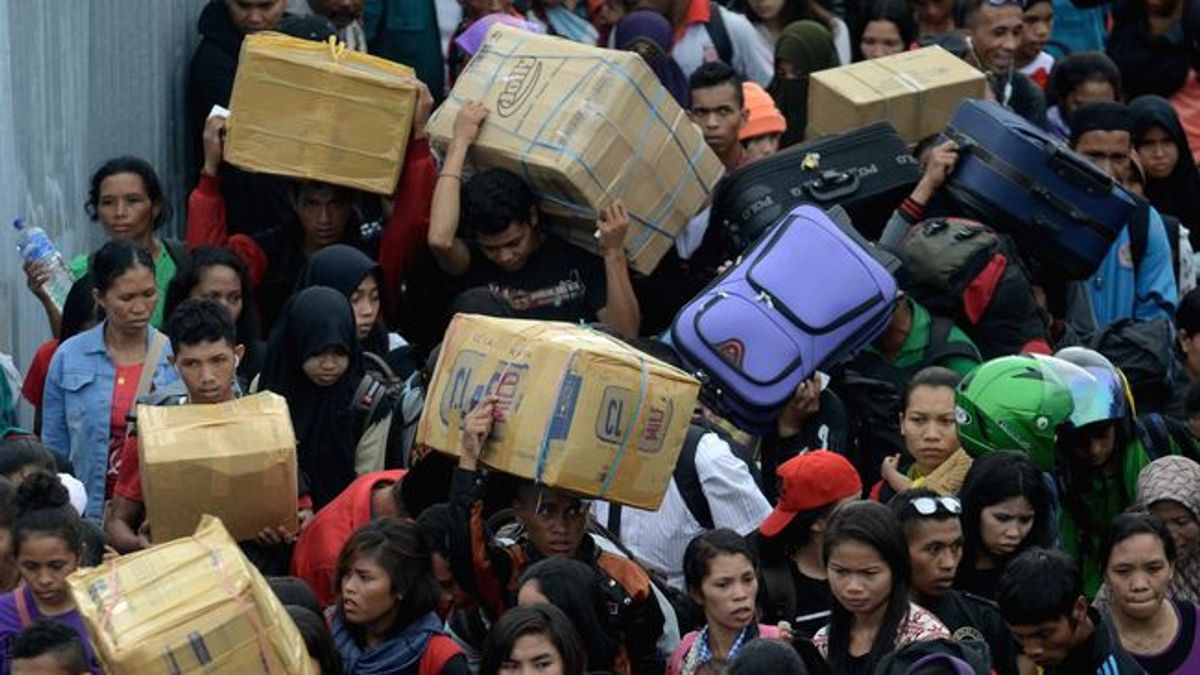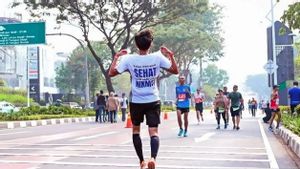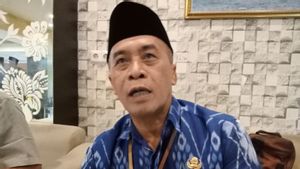JAKARTA - Spokesperson for the Ministry of Transportation, Adita Irawati in Jakarta, Friday, April 8, said the results of a survey conducted by the Research and Development Agency of the Ministry of Transportation noted that there was a spike in homecomers during Lebaran this year. This increase was mainly triggered by the government's policy regarding the handling of COVID-19.
The survey was conducted on 22-31 March 2022 or after the announcement by President Joko Widodo regarding the easing of homecoming, the number of homecomers was recorded at 85.5 million people. With details, the number of travelers from Jabodetabek is estimated at 14.3 million people.
From this survey, it is also known that the majority of homecomers will use land transportation, private cars, and motorbikes.
Jasa Marga in a press release Monday, April 11 through Jasa Marga's Corporate Communication and Community Development Group Head, Dwimawan Heru Santoso explained, it is estimated that 2.54 million vehicles will leave the Jabodetabek area on D-7 to D+7 Eid Al-Firi or in the 25th period. April to 10 May 2022.
That number has increased by 10.8 percent in the 2021 Eid period with a prediction that the peak flow of homecoming will fall on Friday 29 April 2022. The return flow is predicted to peak on Sunday 8 May 2022. For the reverse flow of the number of vehicles in the same period 2.57 million vehicles, up 12.9 percent from the 2021 Eid period.
The Origin of Homecoming TraditionGoing home or going home has become a hereditary tradition carried out by Indonesian people before Eid. People are willing to line up, jostling and experiencing traffic jams for the sake of the tradition of returning home, with the aim of meeting and staying in touch with family in their hometown. Homecoming in particular is indeed pinned for the moment to return home during Lebaran. So how did the Eid homecoming tradition begin in Indonesia?
The term Lebaran homecoming only developed around the 1970s. At that time, Jakarta as the capital city experienced rapid economic growth, with various advances compared to other cities in Indonesia.
Jakarta is a dream city for most Indonesians. As many as 80 percent of urbanists come to Jakarta to try their luck looking for work. For those who already have a job, generally they will only get a long holiday on Eid. This momentum is used to visit family.
This continued and took root as many urbanists tried their luck. Not only in Jakarta, the tradition of moving people from villages to cities also occurs in the capital cities of other provinces in Indonesia. Especially with the implementation of regional autonomy in 2000, more and more people are looking for their fortune in the city.

Just like in Jakarta, those who work in the city can only return to their hometowns during long holidays, namely Eid. So that this momentum expands and looks so developed into a phenomenon.
The media also has a big role in branding this return home activity into a mandatory tradition during Lebaran. With the company and government programs that make it easier to return home, this tradition is taking root even more. This activity is also a reminder of regional origins for those who migrate.
In the past, the tradition of going home for nomads also aimed to show the existence of its success. In addition, it is also an opportunity to share sustenance with relatives who have been left behind for a long time.
"So, at first when going home with the holidays, they looked for the social legitimacy of success in big cities and wanted to build a perception of success. That they got a job, a big salary, a luxurious life compared to the village," said sociologist Dwi Winarno.
Currently, said Dwi, the tradition of going home has shifted its meaning because it is no longer an acknowledgment of success, but also to stay in touch or meet with family.
"The holidays are long, so it allows them to do many activities in the village, such as nostalgia and reflection on life in the city," said Dwi.
The homecoming tradition is a habit that has not been replaced even though technology is getting more sophisticated to wish you a happy Eid. Homecoming is an opportunity to meet extended family and celebrate.
Economic Impact of HomecomingBehind this annual tradition of every Lebaran, there is an economic wheel that spins through villages throughout the archipelago. Purchasing power in the countryside increases because a lot of money flows from the city center to the villages.
Director of Indonesia Development and Islamic Studies (IDEAS) Bhima Yudhistira said before the pandemic it was estimated that there would be at least Rp. 142.2 trillion in circulation of money from travelers for transportation, accommodation, consumption and recreation purposes during Lebaran 2019. This is from a projection of at least 33 million travelers. If added to the calculation of the holiday allowance (THR) and the provincial minimum wage, the financial projections will swell by IDR 63.6 trillion.
In 2021, Bank Indonesia (BI) will prepare Rp152.14 trillion in cash to meet the needs of the community during Ramadan or Eid al-Fitr 1442 H. The homecoming ritual is proven to be able to move the economy in all sectors. This number increased by 39.33% compared to 2020 which was Rp. 109.20 trillion.

BI data shows that the accumulation of net inflows or money coming in compared to money going out in Java is getting higher. This means that the velocity of money in Java tends to increase during the Lebaran homecoming season.
BI predictions for East Java representatives, cash flow in the second quarter of 2021 or Lebaran will experience a net-outflow (more money that comes out than the bank). Net-outflows still occur despite the ban on going home, which has the potential to suppress economic movements or the circulation of money in the regions.
Contrasting phenomena actually occur in other cities which show a negative net inflow. Even in Jakarta the net inflow could be minus IDR 13.7 trillion. This cannot be separated from the movement of workers from Jakarta to other provinces on the island of Java so that the circulation of money in Jakarta has stopped.
Homecoming in Other CountriesIf going home is so lively in Indonesia, what about other countries? They also have traditions like Indonesia. There are some who have the tradition of going home like in Indonesia. Anything?
Malaysia:
This country, which is still closely related to Indonesia, also has a homecoming tradition ahead of Eid al-Fitr. Because the majority of Malaysians are Muslims, so the crowds during Lebaran homecoming are also felt,
Homecoming residents are those who migrate to the city to work. However, Malaysia does not recognize the term homecoming or returning home. Malaysians refer to the homecoming tradition as 'balik kampong' or 'holiday exodus', referring to the hustle and bustle of traveling to their hometowns which generally begins one week before 1 Shawwal. Malaysia has two homecoming days, namely during Eid and Chinese New Year.
India:
India is one of the most populous countries in the world, and the Muslim population is 14.5 percent of the total population. Although the Muslim community is a minority, Eid celebrations are quite lively, especially during homecoming.
In addition, every year Muslim and non-Muslim Indians will return home to celebrate the festival of light or Diwali. The celebration falls in October or November, and is celebrated for 5 consecutive days. This celebration is as festive as Eid al-Fitr, because Indians will flock to their hometowns.
The scene of going home in this country is more excited than in Indonesia. Public transportation such as trains will be so overcrowded that many residents are hanging from doors, windows, and the roof of the train.

China:
The total population of China now reaches more than 1.4 billion people. About 18 million people embrace Islam. Most of the Muslim population lives in Xinjiang and Yunnan. Both cities always celebrate Lebaran festively.
The homecoming tradition of Chinese citizens celebrating Chinese New Year is also one of the biggest homecoming customs in the world. Homecoming ahead of Chinese New Year is known as Chunyun. Returning home with the most dense currents occurs during Chinese New Year. Chinese New Year celebrations in China are much more lively than Eid al-Fitr.
The phenomenon of going home in Indonesia is unique and cannot be found in other countries, especially the massive number of homecomers. Homecoming is also a psychological therapy to take advantage of the Lebaran holiday to travel after a year of busy work routines so that when you come back to work you have a new spirit.
The English, Chinese, Japanese, Arabic, and French versions are automatically generated by the AI. So there may still be inaccuracies in translating, please always see Indonesian as our main language. (system supported by DigitalSiber.id)









